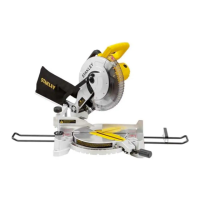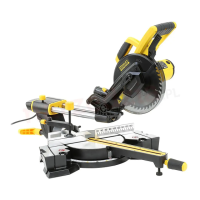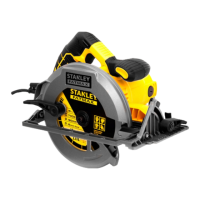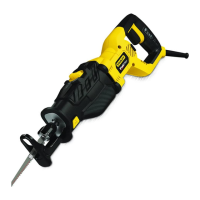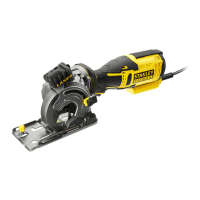27
ENGLISH (Original Instructions)
protruding blade may cut objects that can cause
kickback.
SAFETY GUIDELINES/DEFINITIONS
It is important for you to read and understand this manual.
The information it contains relates to protecting Your Safety
and Preventing Problems. The symbols below are used
to help you recognize this information.
DANGER! Indicates an imminently hazardous
situation which, if not avoided, will result in death or
serious injury.
WARNING! Indicates a potentially hazardous
situation which, if not avoided, could result in death
or serious injury
CAUTION! Indicates a potentially hazardous
situation which, if not avoided, may result in minor or
moderate injury
CAUTION! Used without the safety alert symbol
indicates potentially hazardous situation which, if
not avoided, may result in property damage.
ADDITIONAL SAFETY RULES FOR
CIRCULAR SAWS
WARNING! Some dust created by power
sanding, sawing, grinding, drilling, and other
construction activities contains chemicals known to
cause cancer, birth defects or other reproductive
harm. Some examples of these chemicals are:
♦ Lead from lead-based paints,
♦ Crystalline silica from bricks and cement and other
masonry products,
♦ Arsenic and chromium from chemically-treated lumber
(CCA).
Your risk from these exposures varies, depending on how
often you do this type of work. To reduce your exposure to
these chemicals:
♦ Work in a well ventilated area, and work with approved
safety equipment, such as those dust masks that are
specially designed to filter out microscopic particles.
♦ Avoid prolonged contact with dust from power
sanding, sawing, grinding, drilling, and other
construction activities. Wear protective clothing
and wash exposed areas with soap and water.
Allowing dust to get into your mouth, eyes, or lay on
the skin may promote absorption of harmful chemicals.
CAUTION! Wear appropriate hearing protection
during use. Under some conditions and duration of
use, noise from this product may contribute to
hearing loss.
♦ Snagging the lower guard on a surface below
the material being cut can momentarily reduce
operator control. The saw can lift partially out of the
cut increasing the chance of blade twist. Ensure there is
sufficient clearance under the workpiece.
♦ When necessary to raise lower guard manually,
use the retracting lever.
♦ Keep the Blades Clean and Sharp. Sharp blades
minimize stalling and kickback. The use of dull and/ or
dirty blades can increase the saw loading causing the
operator to push harder which promotes twisting.
CAUTION! Laceration Hazard. Keep hands
away from cutting areas. Keep hands away from
blades. Never place hands in front of or behind the
path of the blade while cutting. Do not reach underneath
work while blade is rotating. Do not attempt to remove cut
material when blade is moving.
♦ Support large panels. Large panels must be
supported as shown (FIG. A) in this manual to minimize
the risk of blade pinching and kickback. Material
supported only at the ends (FIG. B) will lead to blade
pinching. When cutting operation requires the resting of
the saw on the workpiece, the saw shall be rested on
the larger portion and the smaller piece cut off.
♦ Use only correct blades and blade assembly
components when mounting blades. Do not use
blades with incorrect size holes. Never use defective or
incorrect blade washers or bolts. Follow blade assembly
procedures.
♦ Adjustments. Before cutting be sure depth and bevel
adjustments are tight.
♦ Support and secure the work properly. Insure that
the material to be cut is clamped (Fig. C), and solidly
supported and balanced on a strong, stable and level
work surface. Support the work so that the wide portion
of the saw shoe is on the portion of the material that
doesn’t fall after the cut is made. Never hold cut off
piece by hand (FIG. D). Kickback from blade pinch can
result. Keep both hands on saw at all times.
♦ Stay alert and exercise control. Keep body
positioned to one side of blade. Always maintain a firm
grip and control of saw with both hands. Do not change
hand grip or body position while saw is running. Take
precaution to avoid injury from cut off pieces and other
falling material during operation.
DANGER! Release switch immediately if blade
binds or saw stalls.
RESIDUAL RISKS
Additional residual risks may arise when using the
tool which may not be included in the enclosed safety
warnings. These risks can arise from misuse, prolonged
use etc. In spite of the application of the relevant safety
regulations and the implementation of safety devices,
certain risks cannot be avoided. These are:
♦ Injuries caused by touching any rotating/moving parts.
♦ Injuries caused when changing any parts, blades or
accessories.
♦ Injuries caused by prolonged use of a tool. When using
any tool for prolonged periods ensure you take regular
breaks.
♦ Impairment of hearing.
♦ Health hazards caused by breathing dust developed
when using your tool (example:- working with wood,
especially oak, beech and MDF.)
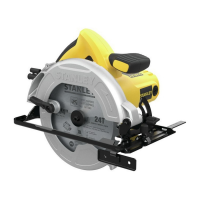
